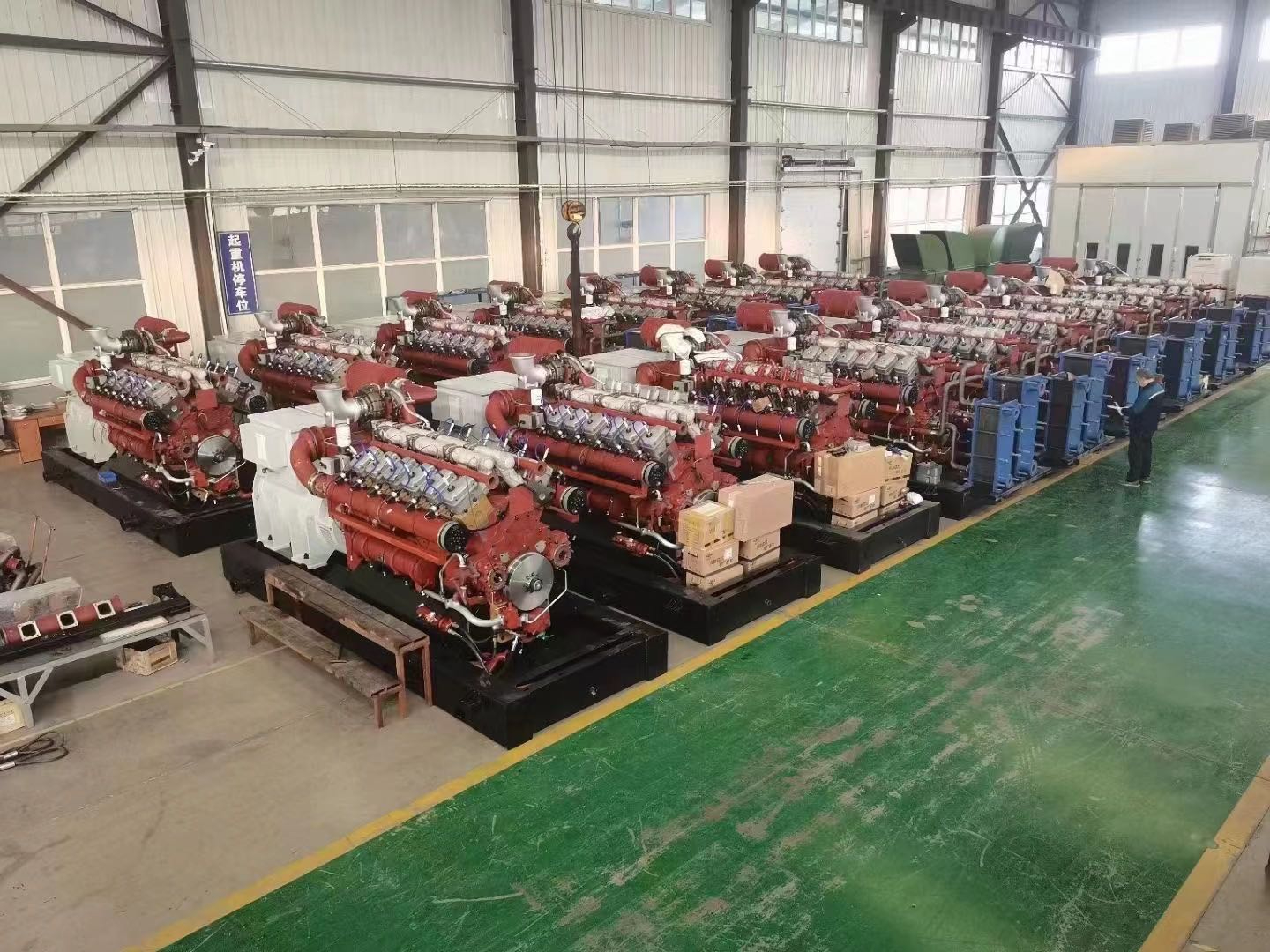 联系 - 热线
联系 - 热线
0531-69953988

 联系 - 热线
联系 - 热线
制氢尾气发电机组在工厂中有什么用?
在当今追求可持续发展的时代,能源的高效利用与环境保护成为全球关注的焦点。制氢尾气发电机组的出现,为解决工业废气排放与能源浪费问题提供了创新的解决方案。它宛如一位神奇的 “变废为宝大师”,将原本被视为污染源头的制氢尾气转化为清洁电能,实现了经济效益与环境效益的双赢。
In today's era of pursuing sustainable development, the efficient utilization of energy and environmental protection have become the focus of global attention. The emergence of hydrogen exhaust gas generator sets provides innovative solutions to solve the problems of industrial waste gas emissions and energy waste. It is like a magical 'waste to treasure master', converting hydrogen exhaust gas, which was originally considered a source of pollution, into clean electricity, achieving a win-win situation for economic and environmental benefits.
制氢尾气:曾经的 “污染包袱”
Hydrogen production exhaust gas: a former 'pollution burden'
在化工生产的制氢车间,当天然气、甲醇等原料历经高温催化反应生成氢气后,一股成分复杂的尾气随之排出。这股尾气中,不仅包含未被完全利用的氢气、氮气,还裹挟着少量甲烷、一氧化碳等可燃气体,同时,硫化物、粉尘颗粒和水蒸气也混迹其中。以往,这些尾气常被直接排放到大气中,带来诸多危害。氢气作为高效清洁的能源,就这样被白白浪费;尾气中的硫化物会形成酸雨,侵蚀建筑;粉尘加剧空气污染,危害人体健康;更危险的是,可燃气体与空气混合后,若达到一定浓度,遇到火花便可能引发爆炸,给工业生产和周边环境带来严重的安全隐患。
In the hydrogen production workshop of chemical production, when natural gas, methanol and other raw materials undergo high-temperature catalytic reactions to generate hydrogen gas, a complex tail gas is discharged along with it. This exhaust not only contains underutilized hydrogen and nitrogen, but also carries a small amount of combustible gases such as methane and carbon monoxide. At the same time, sulfides, dust particles, and water vapor are also mixed in. In the past, these exhaust gases were often directly emitted into the atmosphere, causing many hazards. Hydrogen, as an efficient and clean energy source, is wasted in vain; Sulfides in exhaust gases can form acid rain and erode buildings; Dust exacerbates air pollution and poses a threat to human health; What is even more dangerous is that when combustible gases mix with air and reach a certain concentration, they may trigger explosions when encountering sparks, posing serious safety hazards to industrial production and the surrounding environment.
净化处理:为发电筑牢根基
Purification treatment: laying a solid foundation for power generation
当制氢尾气发电机组启动运转,对尾气进行净化处理成为首要任务,这也是保障设备稳定运行的关键前提。从制氢装置排出的尾气,宛如一个装满杂物的 “混合罐”。其中,硫化物如硫化氢,带着刺鼻的臭鸡蛋味,会像腐蚀性的液体一样侵蚀发电机组的金属部件;粉尘颗粒虽小,却如同沙粒在管道中流动,不断磨损设备的精密零件;水蒸气的存在则会影响气体燃烧的效率,甚至在低温时凝结成水,造成管道堵塞。
When the hydrogen production tail gas generator set starts running, purifying the tail gas becomes the primary task, which is also a key prerequisite for ensuring the stable operation of the equipment. The exhaust gas discharged from the hydrogen production unit is like a "mixing tank" filled with debris. Among them, sulfides such as hydrogen sulfide, with a pungent odor of rotten eggs, will corrode the metal parts of the generator set like corrosive liquids; Although the dust particles are small, they flow like sand particles in the pipeline, constantly wearing down the precision parts of the equipment; The presence of water vapor can affect the efficiency of gas combustion, and even condense into water at low temperatures, causing pipeline blockage.
为使尾气满足发电要求,发电机组配备了一套高效的净化系统。这套系统犹如一个严谨的 “气体净化工厂”,首先通过多层滤网组成的过滤装置,像筛子筛选细沙般拦截粉尘等固体杂质;然后利用吸附塔内的特殊材料,通过化学反应吸收硫化物等有害气体;最后经过干燥设备去除水蒸气,让尾气变得纯净干燥,为后续发电做好充分准备。
To meet the power generation requirements, the generator set is equipped with an efficient purification system. This system is like a rigorous "gas purification factory", first using a filtering device composed of multiple layers of filters to intercept solid impurities such as dust like a sieve screening fine sand; Then, using special materials inside the adsorption tower, harmful gases such as sulfides are absorbed through chemical reactions; Finally, the water vapor is removed by a drying device to make the exhaust gas pure and dry, fully preparing for subsequent power generation.
智能发电:应对气源波动挑战
Intelligent power generation: addressing the challenge of gas source fluctuations
净化后的尾气进入发电环节,这是发电机组实现价值的核心阶段。由于制氢过程中原料配比、反应温度等因素不断变化,尾气的流量和成分也随之波动,有时氢气含量较高,有时甲烷比例降低,难以预测。传统发电设备面对这种不稳定的气源,就像汽车在颠簸道路上行驶,难以保持稳定的速度和效率。
The purified exhaust enters the power generation process, which is the core stage for the generator set to realize its value. Due to the constantly changing factors such as raw material ratio and reaction temperature in the hydrogen production process, the flow rate and composition of the exhaust gas also fluctuate accordingly. Sometimes the hydrogen content is high, and sometimes the methane ratio decreases, making it difficult to predict. Traditional power generation equipment faces this unstable gas source, just like a car driving on bumpy roads, making it difficult to maintain stable speed and efficiency.

而制氢尾气发电机组采用了先进的智能调控技术,轻松应对这一挑战。在发电机组的进气口、燃烧室等关键位置,安装了高精度传感器,这些传感器如同敏锐的 “监测员”,实时捕捉尾气的流量、浓度和压力等信息,并迅速将数据传输给控制系统。控制系统则像一位经验丰富的 “指挥官”,根据这些数据通过智能算法自动调整运行参数,比如精准控制空气与尾气的混合比例,确保可燃气体在燃烧室内充分燃烧,将更多的化学能转化为电能。如此一来,无论尾气如何波动,发电机组都能稳定高效地工作,最大限度地挖掘其中的能源潜力。
The hydrogen production tail gas generator unit adopts advanced intelligent control technology to easily cope with this challenge. High precision sensors are installed at key locations such as the intake and combustion chamber of the generator set. These sensors act as sharp "monitors", capturing real-time information such as exhaust flow rate, concentration, and pressure, and quickly transmitting the data to the control system. The control system is like an experienced "commander", automatically adjusting operating parameters through intelligent algorithms based on this data, such as accurately controlling the mixing ratio of air and exhaust gas, ensuring that combustible gases are fully burned in the combustion chamber, and converting more chemical energy into electrical energy. In this way, no matter how the exhaust gas fluctuates, the generator set can work stably and efficiently, maximizing its energy potential.
余热回收:让能源 “物尽其用”
Waste heat recovery: making full use of energy resources
在尾气燃烧发电的过程中,大量热量随着高温废气和冷却水散失,若不加以利用,便是对能源的极大浪费。制氢尾气发电机组的设计者们精心设计了一套余热回收系统,如同一位精打细算的 “能源管家”,将不同温度的余热进行梯级利用。
In the process of tail gas combustion for power generation, a large amount of heat is lost along with high-temperature exhaust gas and cooling water. If not utilized, it is a great waste of energy. The designers of the hydrogen exhaust gas generator unit have carefully designed a waste heat recovery system, like a meticulous "energy steward", to cascade the utilization of waste heat at different temperatures.
高温废气的热量通过余热锅炉转化为高温高压蒸汽,驱动汽轮机进行二次发电,进一步提高能源利用效率;中温余热可用于工业生产中的预热工序,比如为制氢原料加热,减少生产过程中的能源消耗;低温余热则可用于厂区供暖或生活热水供应,在寒冷的冬季为车间和员工宿舍带来温暖,让每一份热量都得到充分利用。
The heat from high-temperature exhaust gas is converted into high-temperature and high-pressure steam through a waste heat boiler, which drives a steam turbine for secondary power generation and further improves energy utilization efficiency; Medium temperature waste heat can be used for preheating processes in industrial production, such as heating hydrogen raw materials to reduce energy consumption during the production process; Low temperature waste heat can be used for heating in the factory area or supplying hot water for daily life, bringing warmth to the workshop and employee dormitories in the cold winter, allowing every heat source to be fully utilized.
本文由制氢尾气发电机组友情奉献.更多有关的知识请点击:我们将会对您提出的疑问进行详细的解答,欢迎您登录网站留言.
This article is a friendly contribution from the analysis of gas generator sets For more information, please click: We will provide detailed answers to your questions. You are welcome to log in to our website and leave a message
业务分类
Business classification产品推荐
product recommendation联系方式
Contact Information

截屏,微信识别二维码